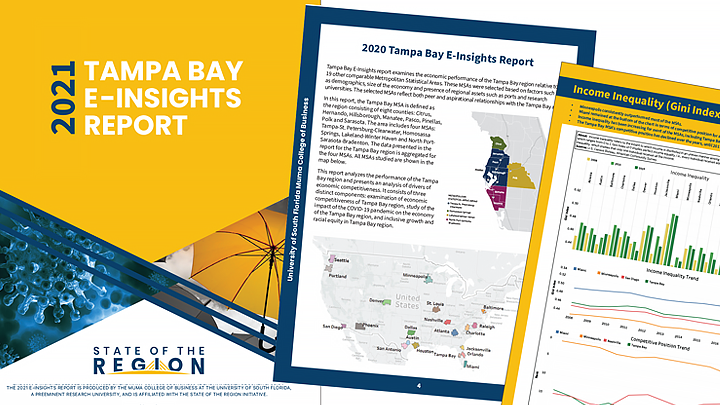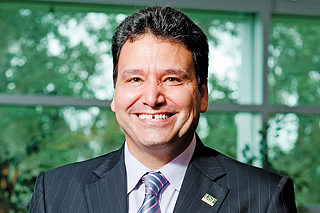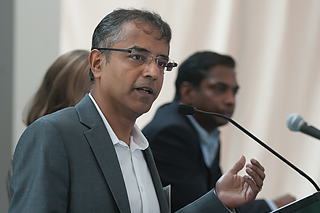Current Features
Quality of Life: USF Study Helps Guide Business, Community Leaders

By Keith Morelli ’78| Muma College of Business
TRYING TO GAUGE THE QUALITY OF LIFE in the Tampa Bay region is no simple task. It relies on traditional data, such as census reports, employment numbers, graduation rates and income statistics. Some data comes from sources that cover the past year, two or 10 to uncover trends that point to where the area is going.
Other, unconventional sources, mined by the USF Muma College of Business Center for Analytics and Creativity, focus on real-time information. Information systems faculty and a group of hand-selected graduate students dove into Google searches, Indeed job classified posts and Zillow real estate listings to find out how the Tampa Bay region fares against 19 other cities of similar size and demographics.
The resulting document: The Tampa Bay E-Insights Report 2021, an exhaustive study that reveals the attitudes, culture and economic viability of the Tampa Bay region.
The 68-page report, which includes analyses, charts and graphs that back up its findings, was delivered to some 1,300 business and governmental leaders at a virtual State of the Region conference earlier this year. It was accompanied by the Regional Competitiveness Report, put together by the Tampa Bay Partnership, and together they were presented to inform decisions made by leaders in how to improve the quality of life and boost the economy within the region.
The difference between the two reports is that the E-Insights Report relies on real-time, big-data tools that provide insights not found in traditional measures.

“Most economic conclusions are based on data drawn from a year — or even a decade — ago and if the pandemic and economic crises have shown us anything,” says Moez Limayem, dean of the Muma College of Business, “it’s how quickly markets and consumer behavior can change and that fresh data must drive decisions as much as historic data.”
By looking at real-time data to get a snapshot of the current mood and concerns of the region, USF scholars found that transit availability, STEM education and increasing the median household income are the three variables that can most readily help the Tampa Bay region make the greatest strides in almost all areas measured in the report.
“These three things, more than anything else, are the drivers that will improve the region’s GRP (gross regional product) and prosperity,” Limayem says.
This is the fourth year the partnership and USF have combined to compile the comprehensive reports, but this year, researchers had to navigate some unusual circumstances: COVID-19 and the social injustice unrest that swept the nation over the summer.
The data give a more current picture of the attitudes, standings and economics — both positive and negative — about the region in comparison with 19 other similar municipalities around the nation.
Among the takeaways of the Tampa Bay E-Insights Report 2021:
- Investments in transit infrastructure, education and labor force participation are key to economic growth.
- The Tampa Bay region is less impacted by COVID-19 when compared to Miami and Orlando.
- The economy in the Tampa Bay region is recovering after suffering a dip in the month of April.
- Regular commerce and travel in the Tampa Bay region have been less affected than in most other regions in the study.
- By mid-October, consumer spending levels in the Tampa Bay region recovered to 100 percent of the January value.
- The Tampa Bay region stands in the lowest quantile in terms of number of job openings per million individuals.
Dave Sobush ’MBA 03,director of policy and research with the Tampa Bay Partnership, says rising unemployment during the COVID-19 pandemic hit the local economy hard.
“In February, there was 3 percent unemployment,” he says. “In April, there was 13 percent, the highest on record.”
Travel and tourism also were hit hard, he says, “and that will take some time to recover.”
Conversely, the real estate market remained strong here, Sobush says. From June to November, the rate of home sales was double digit over the same period the previous year.
Reflecting the summer’s Black Lives Matter demonstrations, Sobush says the issues of racial inequality were addressed in the Regional Competitiveness Report. Research revealed that the widening gap of kindergarten through 12th grade passing rates between white and Black students was significant. Between 2018 and 2019, there was a 30 percent difference between white and Black student passing rates, he says. That likely reflected a lack of access to digital resources, perhaps no computers in Black households or lack of Internet availability, and that can result in further lost educational and, ultimately, job opportunities down the road.
The Tampa Bay region ranked No. 18 out of 20 cities in the study in digital access.
“There are severe repercussions of these educational gaps,” he says.
However, there were some marked improvements more recently, says Shivendu Shivendu, a professor in the Center for Analytics and Creativity. The gap between Black and white student access to digital resources over the last year or so is narrowing, he says.
“We are on the right path,” he says. “If we continue to do what we are doing, we can bridge that gap.”
A couple of snapshots in the E-Insights Report showed that inquiries on social media and other online platforms between June and August revealed a reduction in inquiries into divorce, says Balaji Padmanabhan, director of the Center for Analytics and Creativity. Online searches for regional malls, retail outlets and restaurants fell off during the COVID-19 pandemic.
“But this has recovered,” he says, “though we are not close to where we were pre-pandemic.”
“Overall,” he says, “the Tampa Bay area seems to be recovering (from the summer’s economic hardships) quite well.”
Brian Lamb ‘98 and MBA ‘17, Life Member, the global head of diversity and inclusion with JPMorgan Chase and vice chair of the Florida Board of Governors, lauded the effort that went into the research, commenting on the focus on systemic racial inequality and its impact on American culture.
“Diversity and inclusion have to be built,” Lamb says. “Diversity and inclusion have to be woven into the fabric of business. Businesses have to set goals and achieve certain levels of accountability that can be measured. And businesses must invest in education, from high schools to universities.”
Limayem says the collaboration between the Muma College of Business and the Tampa Bay Partnership has resulted in research that is relevant and impactful. It can spark real action region-wide.
“We need private organizations to enter public-private partnerships,” he says, “where very high-quality, real-time data can be used to accurately measure the health and prosperity of the vulnerable population, if we want to have a better real-time handle on policy issues to promote inclusive growth.”
Students Play Important Role in Generating Useful Insights
SOME RESEARCH CAN GO deep into the weeds, so much so that only erudite academics can fathom the meaning of the data, understand the findings and apply the conclusions.
But an annual project in which Muma College of Business faculty collaborate with business graduate students in School of Information Systems and Management is different. Though the charts and graphs generated can be a bit daunting, within all the raw data lies a clear pathway to improve the quality of life for everyone in the Tampa Bay region. It is a unique collaboration between teacher and student. Faculty members add to their body of work and graduate students learn the science of big data. They also become more attractive for potential employers.

Since 2017, Balaji Padmanabhan, director of the college’s Center for Analytics and Creativity; Shivendu Shivendu, a professor who teaches analytics; and a handful of hand-picked graduate students work together on ways to gauge what Tampa Bay life is like in real time and compare that to life in 19 other U.S. cities of similar size and demographics.

They delve into social media such as Indeed for job listings, Zillow for real estate transactions and search engines such as Google trends and much more. Through this, they are able to paint a current picture of the region’s culture and economics, not based on traditional statistics that are a year or more old, but data that are perhaps days old.
Their findings are contained in the 2021 Tampa Bay E-Insights Report, a companion to the Regional Competiveness Report compiled by the Tampa Bay Partnership. Together, the reports inform the decisions of business and governmental leaders on how to improve the quality of life in the region, from reducing unemployment rates to narrowing the wealth gap and to entertainment and hospitality options.
This collaboration between faculty and graduate students is key to the success of the endeavor.
“It is important to have graduate students as an integral part of the project, both for the quality of research and the professional growth of the graduate student,” Shivendu says. “The research for the project analyzes a very large volume of data on traditional economic variables as well as real-time indicators of inclusive economic growth. Participation of graduate students ensures integrity of data collection and preparation, data analytics, data visualization and statistical analysis.
“Moreover,” he adds, “it is an excellent opportunity for our graduate students to work on a real-world, high-impact project and gain practical experience in implementing concepts and tools learned in class to generate insights on key regional economic indicators.”
To successfully capture and analyze the data, the roles of each researcher must be clearly defined. The research mentors are the faculty. A doctoral student in the School of Information Systems and Management serves as project leader and advanced students in the MS in Business Analytics and Information Systems program are the research associates.
Getting students motivated is not an issue, Shivendu says. Graduate students typically are excited about working on this high-profile project.
“Not only does it give them an opportunity to have hands-on learning of data analytics concepts but it also allows them to work on a real-world project with immense policy implications,” Shivendu says. “It provides them with a strong credential on résumés and the visibility in front of a large business community, which also acts as a positive in job searches.”
Choosing the right graduate students is a detailed process, he says.
“We interview shortlisted applicants,” Shivendu says, “and select the three to four students who best fit the requirements based on interest, past experience, personal qualities like leadership, initiative, ability to work with marginal supervision, and the fit of the project with their career goals.”

Roohid Syed, MS ’18, is the doctoral student who supervises the work of the graduate students.
“The academic projects that graduate students do in graduate courses typically give hands-on experience to the students,” he says. “Students take on those projects to learn how to implement the theoretical concepts learned in class. The focus is more on learning rather than the outcome itself.
“On the other hand, in the case of the E-Insights Report, the outcome is extremely crucial since it is consumed by the civic and the business leadership of the region,” Syed says. “Grad students working for this project strive to come up with innovative and creative ideas to produce useful insights.
“Also, the scope of this project is much wider and deeper than regular graduate projects.”
There were challenges along the way, he says, noting that the biggest obstacle was
devising new data sources and new ways to study the data sources to produce novel
insights. The data-gathering process can be an extremely painstaking process, and
it requires enormous amounts of creativity to extract and analyze the data.
“The rewards are that this project will give good experience to the students to work
with complicated data sources,” Syed says. “Learning from the data is sometimes extremely
difficult. It requires a lot of preprocessing, formatting and application of suitable
method to analyze the data. The labor that the students go through in this project
will prepare them for real-world challenges of data analysis.”